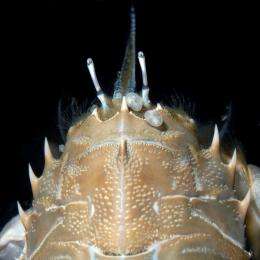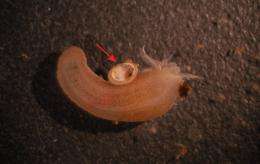Drivers of marine biodiversity: Tiny, freeloading clams find the key to evolutionary success

What mechanisms control the generation and maintenance of biological diversity on the planet? It's a central question in evolutionary biology. For land-dwelling organisms such as insects and the flowers they pollinate, it's clear that interactions between species are one of the main drivers of the evolutionary change that leads to biological diversity.
But the picture is much murkier for ocean dwellers, mainly because the scope of ecological interactions remains poorly characterized for most marine species. In one of the first efforts to examine how species interactions drive diversification of ocean-dwelling organisms, two University of Michigan researchers and an Australian colleague looked at the lifestyle choices within an exceptionally diverse superfamily of tiny clams, the Galeommatoidea.
They found that the fingernail-size-and-smaller clams' propensity to shack up with much larger, burrowing creatures such as sea urchins, shrimp and worms was a key adaptation that led to the evolutionary success of the superfamily, as measured by its "megadiverse" status among marine bivalves. There are about 500 described species of galeommatoidean clams and many more undescribed species.
By becoming the uninvited house guests of their burrowing hosts, these freeloading, thin-shelled clams acquire a safe haven from predators prowling soft-bottomed sediments, where there's nowhere else to hide. Gaining this deep refuge opened up a vast habitat type – soft-bottom marine sediments composed of sand, silt and clay – that would otherwise have remained unavailable to these clams.

Galeommatoidean clams are found worldwide in all the major ocean basins, in both rocky and soft-bottom habitats. Some of the clams live a solitary existence, while others form so-called commensal relationships with larger invertebrate hosts. A commensal relationship is one in which one organism benefits and the other is not harmed.
In a study scheduled for online publication Aug. 8 in the journal PLoS ONE, the U-M-led team performed a statistical analysis of the lifestyle and habitat preferences of 121 galeommatoidean species based on 90 source documents.
The researchers found that all but two of the 57 free-living species were restricted to hard-bottom habitats, typically hidden in rocky or coral-reef crevices. In contrast, 56 of the 60 commensal species were soft-sediment dwellers.
The results show that formation of commensal associations by galeommatoidean clams is robustly correlated with living in sediments. That finding is consistent with the hypothesis that evolution of these commensal relationships was primarily an adaptation to living in soft-bottom habitats.
"What was surprising was the overwhelming evidence that commensalism is associated with the soft-bottomed habitat. You seldom get such clear-cut data in an ecological study," said Jingchun Li, a doctoral student in the U-M Department of Ecology and Evolutionary Biology and first author of the PLoS ONE paper.
Clams and other bivalves have evolved two general anti-predator strategies: armor (think oysters) and avoidance. Since galeommatoidean clams have fragile shells, they must go the avoidance route, and following a larger host into a burrow allows the clams to attain depths of up to 3 feet – hundreds of times their body lengths.
Galeommatoidean clams lack the siphons (often called necks) that other clams use to feed and breathe while remaining safely buried in the sand. Siphons consist of two tubes: Water enters the clam's body through one siphon, flowing into gills that capture oxygen and trap food. The water then flows out of the clam through the other siphon.
The siphon-less galeommatoideans make up for that shortcoming by teaming up with hosts that constantly pump fresh seawater into, through, and then out of their burrows.
"This allows the clams to stay deep and safe, while still having access to water and oxygen and a food supply," Li said. In this way, the hosts act as giant siphon substitutes for the tiny clams.
"Jingchun's finding that the type of sea floor habitat strongly modulates the ecological importance of commensalism in these megadiverse clams gives us a novel insight into how ostensibly irrelevant background physical conditions may shape the evolution of species interactions in marine environments," said study co-author Diarmaid O'Foighil, Li's adviser and the director of the U-M Museum of Zoology.
The second phase of the clam study will test the relative importance of free-living and commensal lifestyles in driving galeommatoidean diversification. Using data from about 300 species, the researchers will construct a phylogenetic tree for the entire superfamily.
Journal information: PLoS ONE
Provided by University of Michigan



















